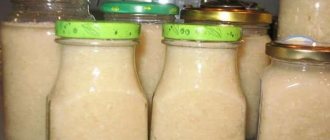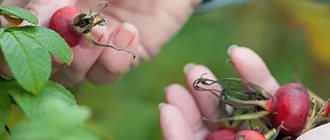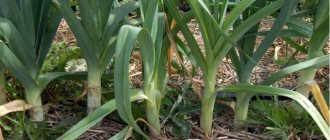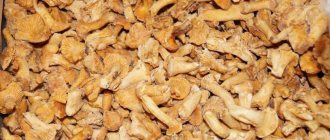Benefits of freezing: what is the difference between frozen greens and fresh ones?
Fresh parsley contains a huge amount of useful substances: vitamins A, C, E, B, PP, magnesium, potassium, calcium, phosphorus, sulfur, iron, iodine, manganese, copper, zinc, fluorine and sodium. Vitamins and minerals are not afraid of exposure to negative temperatures, so the frozen product contains them in full. Only the amount of ascorbic acid decreases (by 10% over six months).
Greenhouse parsley purchased in winter is practically devoid of useful vitamins and microelements, unlike frozen at home.
In terms of calorie content, the ratio of proteins, fats and carbohydrates, the frozen product is close to fresh greens. 100 g of fresh greens contains 49 kcal, 3.7 g of protein, 0.4 g of fat, 7.6 g of carbohydrates. 100 g of frozen parsley contains 50 kcal, 4 g protein, 0 g fat, 8 g carbohydrates.
Defrosting and application options
Thawing is only required when using parsley in cold dishes. To defrost, you need to transfer the required amount from the freezer to the refrigerator compartment. After a while, drain the juice. Hot dishes are frozen immediately. This way it better retains its shape, aroma, and nutrients.
Options for using frozen workpieces:
- hot dishes - soups, stews, stewed vegetables, meat;
- sauces, gravies, dressings;
- smoothies, green cocktails;
- salads, appetizers, decoration;
- casseroles, minced meat, various fillings.
Don't forget about the wonderful cosmetic properties of parsley. It will be used in home masks, will help whiten freckles and pigmentation, get rid of bags under the eyes, and give the skin radiance and youth.
Do not discard parsley juice after defrosting. It can be added to sauces, soups, smoothies, and other dishes with a liquid consistency.
Does frozen parsley retain its beneficial properties?
The frozen product retains its beneficial properties. Regular consumption of fresh or frozen parsley:
- strengthens the immune system;
- reduces blood sugar levels;
- stimulates the digestive system;
- increases appetite;
- improves the functioning of the heart and blood vessels;
- removes waste and toxins from the body;
- has a beneficial effect on vision.
Parsley is a natural antiseptic, has diuretic properties, reduces the intensity of menstrual pain, and prevents the development of prostatitis in men. It is used in cosmetology as a means of cleansing, healing and toning the skin.
But you should refrain from eating parsley if you have cystitis, urolithiasis, bladder diseases, or liver diseases. It is not recommended to eat greens during pregnancy.
Freezing secrets
It is best to freeze greens in small portions. This is convenient if you need to defrost a small amount. When it is frozen in one piece, you have to take it out completely and pick at it with a knife for a long time, cutting off the required amount. In this case, you can accidentally damage the polyethylene or container.
The best way to remove air from bags of greens before freezing is to use a rolling pin, but don't press too hard or you'll see juice coming out, which isn't good. Greens can be frozen not only in chopped form. but also whole branches. Thanks to this, you can always use it exactly as you need it, for example, to decorate cooked dishes.
Preparing parsley for freezing
At home, greens and parsley roots are frozen for the winter.
For freezing, it is better to use freshly cut parsley. It is collected before flowering, when the leaves are soft and rich in aroma. Parsley root is dug up in the fall, when it has gained mass and is maximally saturated with useful substances.
If you don’t have your own garden, buy greens at the market from local sellers. Herbs stored in stores for a long time lose their beneficial properties. The purchased greens must have no signs of damage, bright, rich color, and a characteristic aroma.
Before freezing, the greens are sorted, dry and yellow leaves are removed, and the roots are cut off. Place in a colander and rinse under running water. Place on paper towels and dry well.
Parsley root is thoroughly washed with running water, rubbing with a brush. Use a knife to peel off a thin layer of skin and dry it.
Planning and preparation
Every kitchen has its own recipes for how to properly freeze parsley. To make it convenient to use the herb in cooking later, you need to take into account several important points:
- If possible, it is better to allocate a separate drawer in the freezer for vegetables and spices so that the smells of the products do not mix.
- Parsley should be well washed and thoroughly dried. If you do not remove excess moisture, the mass will eventually freeze into one lump.
- Material for packaging must be prepared in advance: zip bags, food foil, ice trays, plastic containers.
- Freezing must be packaged wisely. It’s good if the greens are immediately divided into portions. Why can't you store the seasoning in one large bag? Every time you take out another portion, the entire contents of the bag will come into contact with air and lose their properties.
- The spice should last all winter.
See also
Is it possible to freeze fresh cabbage for the winterRead
The method for freezing parsley should be tailored to the dishes to which the seasoning will be added. Provide several different options for adding to entrees, salad dressings, and garnishing. There should be a suitable preparation for all your favorite recipes.
In what form and how to freeze parsley correctly
Parsley can be frozen in bunches, whole sprigs or chopped.
For storage, use plastic bags, cling film or sealed containers.
Advice. Use small containers for storage so that the product has less contact with warm air when opening the container. The quality and shelf life of the frozen product depends on this.
To make it easier to find the right product in the freezer and monitor the expiration date, storage containers are marked with the date and name.
We store it correctly
Frozen greens should be placed in hermetically sealed containers to block the odor inside. Look for a place away from fruits, berries, desserts and other flavor-absorbing foods. After a week of being together, some preparations for cheesecakes and bananas for diet ice cream acquire the smell of parsley.
Place the containers at the back of the freezer, not near the door. The warm air outside will melt the grass, release water and stick together. For the same reason, try not to refreeze.
If you follow the harvesting and storage rules, the herb will remain suitable for consumption for 6-8 months. Be sure to mark the bags with the date of preparation. For this reason, it is better to harvest not the first greens (usually these are ready for cutting in June), but the next one - in late August-early September.
Methods for freezing parsley
There are several ways to freeze parsley. The choice depends on the availability of suitable containers and space in the freezer.
Freezing in a bag
With this freezing method, special attention is paid to drying the greens. To prevent the workpiece from sticking together into one lump, there should be no droplets of water on it.
The prepared greens are collected in a bunch, their coarse stems are cut off, and finely chopped.
Advice. Cut stems can be frozen separately and used when cooking broth to give it a spicy aroma.
Chopped greens are placed in bags. The packages are signed and put into the freezer.
Parsley roots are also frozen in bags. To do this, they are cut into slices, folded in portions and put in the freezer.
Freezing in ice trays
The stems of prepared parsley are cut off .
The leaves are crushed with a knife and placed in ice trays, compacted. Pour chilled boiled water on top and place in the freezer for 4 hours. Then the ice cubes are taken out of the molds, put into bags, labeled and put in the freezer for long-term storage.
If you chop the parsley leaves not with a knife, but with a blender, they will give juice. The resulting mass is poured into molds without adding water and frozen. Then the cubes are placed in bags or containers and stored in the freezer.
Parsley root is also frozen in ice trays. To do this, it is grated, placed in molds, filled with boiled water and frozen. The resulting cubes are placed in containers and stored in the freezer.
Freezing in oil
To prevent the greens from completely freezing and to retain their smell and taste, they are frozen in oil. The greens are crushed and placed in ice trays, filling them 2/3 full.
Vegetable oil is poured on top and placed in the freezer. After freezing, the cubes are placed in containers or bags and placed in the freezer for long-term storage.
Freeze sliced
Parsley leaves are finely chopped with a knife. Lay out in a thin layer on a cutting board or tray and put in the freezer for 4-5 hours. Then they are scattered in portions into containers or bags, signed and put away for long-term storage.
Freezing in the form of branches
If there is no time for chopping, parsley is frozen in bunches. To do this, the branches are divided into portioned bundles, the bundle is wrapped in cling film or a bag to form a roll. Sign and put in the freezer for storage.
Preparation of the main ingredient
In order not to be disappointed in this storage method, you need to properly prepare the greens. It is enough to follow a few rules:
- Greens should be as fresh as possible. If it has lain indoors for 2 days and has lost most of its nutrients, then there will be no point in freezing it. You need to calculate the time so as to transfer it from the garden to the freezer with minimal loss in time.
- It is better to collect leaves early in the morning, so they will be more juicy.
- If there is a lot of greenery, you can soak it in water to remove dust and dirt for a few minutes. A small portion can be washed under running water.
- The washed leaves are laid out on a towel or napkin to remove excess moisture.
Parsley is an unpretentious plant with strong immunity, which is practically not affected by diseases and pests. But still, it doesn’t hurt to inspect the greens while washing and drying.
How to store in winter if there is no freezer
If you don't have a freezer at home, you can dry or preserve parsley.
Drying parsley for the winter
The dried product retains its aroma and beneficial properties, although to a lesser extent than the frozen product. The greens and roots are dried. Greens - in separate branches or in chopped form, the root is cut into slices. Store the dried product in glass jars in a dark place.
Tumble Drying
The prepared product is laid out on a pallet. The dryer is set to the “For herbs” mode, the temperature is no more than +45°C. Dry until completely dry.
Oven drying
Parsley sprigs or root segments are laid out on a tray. The temperature in the oven is set at +40…+60°C. Dry the cloves with the door open for 5-6 hours, chopped parsley for 1.5-2 hours.
Air drying
Bunches of greenery are hung under a canopy in a ventilated area or laid out on pallets in twigs or chopped form. The product is stirred periodically to speed up the process. Drying time - from 5 to 20 days.
Microwave drying
Greens or chopped root are placed on a dish. Set the maximum mode to 2 minutes. If the product does not have time to dry completely, the process is repeated.
Canning parsley for the winter
Canning greens is the most labor-intensive way to prepare for the winter.
Dry salting of twigs in jars
Ingredients:
- parsley - 1 kg;
- salt - 200 g.
How to cook:
- The greens are sorted, the roots are cut off, washed and dried.
- The twigs are placed in a sterilized glass jar, sprinkling the mixture with salt.
- Sprinkle additional salt on top to prevent the mass from becoming moldy.
- Cover tightly with a lid and store in the refrigerator.
You can pickle chopped greens using the same method.
In vegetable oil
Ingredients:
- parsley - 300 g;
- little vegetable - 200 ml.
Preparation:
- The prepared greens are cut and placed in a sterilized jar.
- The oil is heated in a water bath.
- Fill the greens with hot oil to the top, leaving no air bubbles.
- Cover with a lid and store in the refrigerator.
This method completely preserves the color, taste and aroma of fresh parsley.
In the marinade
Ingredients:
- parsley - 500 g;
- vinegar - 150 ml;
- water - 0.8 l;
- sugar - 50 g;
- salt - 50 g;
- bay leaf - 2 pcs.;
- garlic - 4 cloves.
Preparation:
- The parsley is sorted, washed, the roots are cut off, lightly dried and chopped.
- The garlic is peeled and chopped with a knife.
- Parsley and garlic are placed in sterilized jars.
- Prepare the marinade: boil water, add sugar, salt and bay leaf, boil for 10 minutes, add vinegar 2 minutes before the end of cooking.
- Boiling marinade is poured over the greens.
- The workpiece is sterilized over low heat for 20 minutes, then the lids are screwed on, the jars are turned over and covered with a blanket.
- Store cooled jars in a cool, dark place.
In what container should I store it?
The best storage option is to use special zip bags. They are very durable, have a clamp and are great for separating all your frozen greens into small portions.
But you can safely take ordinary plastic bags. The main thing is that they are dense enough and do not tear during storage, otherwise the air will begin to dry out the grass. Such freezing will not cause any harm to health, but there will be no benefit either. For insurance, it is better to wrap the bags with cling film. Plastic containers are also great for this purpose. Their huge advantage is the abundance of various shapes and sizes and compactness. Some housewives even use bottles.
You can freeze any spicy herbs: onions, celery root, tarragon, adding coriander to cilantro to enhance the effect, or pouring basil leaves with tomato. After watching the video with the nuances of the process, you can easily stock up on your favorite herbs. In what form to freeze greens (individually or assorted), in what and how to store them is everyone’s personal choice. But, of course, frozen greens are a must-have in any home. Firstly, thanks to it, the taste of your dishes will be much richer and more enjoyable. Secondly, a huge amount of vitamins and nutrients is an excellent help for an organism weakened by a long winter. And finally, freezing greens is very easy and not at all expensive in terms of time and money.
Did you like the recipe? Save it to yourself on Pinterest, FB, VK, OK, G+, Instagram so as not to lose it!
Shelf life of frozen greens
With proper freezing technology and temperatures from -25 to -18 degrees, the shelf life of greens is 1–1.5 years. However, the vitamins in the product begin to degrade after 8 months. Therefore, it is advisable not to delay its use.
If greens are stored at temperatures from -8 to 0 degrees, they begin to lose their beneficial properties after 3 months. And its taste is worse than that of the “heavily frozen” one.
Why can't plants stay in the freezer for several years? During storage, moisture slowly evaporates from them, which leads not only to loss of taste, but also to the destruction of chemical elements.
Freezing parsley in bulk in the refrigerator for the winter
This is the last and easiest way to harvest greens. Greens preserved in this form are convenient to use for decorating potatoes (boiled and fried), adding to salads or meat dishes.
Technology:
- Wash the parsley and dry the branches thoroughly.
- Chop the prepared greens into arbitrary pieces.
- Place in a plastic container with a tight-fitting lid to prevent the parsley from absorbing odors.
- Place the container in the freezer.
- Once frozen, the spice will be ready to use.
An important step is preparing the greens. It is advisable to rinse parsley in salted water. With this processing method, the leaves remain fresh and retain their taste perfectly.
Freezing parsley in cubes in the refrigerator for the winter
One convenient way to freeze parsley is in the form of cubes. Here you can use two types of pouring prepared greens - clean water and melted butter.
For example, silicone molds can be used as containers for freezing. In this case, its size should correspond to one serving. The scheme is simple:
- Chop the prepared greens randomly.
- Fill out the selected form tightly.
- Pour the chosen filling over the Parsley and place it in the freezer, where it should freeze completely.
These portioned cubes are good to use when preparing first courses. It’s enough to take out the frozen one and just put it in the boiling soup a few minutes before it’s ready.
Choosing parsley for freezing in the refrigerator for the winter
For freezing, only bright green herbs should be selected, without diseases or mechanical damage.
The plant must be fresh. For example, when stored in the refrigerator for 3 days, parsley loses up to 50% of its beneficial vitamins. For the same reason, it is not advisable to buy greens for freezing; it is better to use your own, freshly picked.
An important nuance: in most supermarkets, greens are deliberately highlighted to make them look fresher. You should not buy parsley for freezing in such places.
Benefits of freezing
It is worth noting that each method of preserving greenery for the winter has its own advantages. We invite you to consider the benefits of freezing:
- The vitamin complex is preserved. Perhaps the most important thing when preserving a vegetable is to preserve the beneficial substances contained in it. Therefore, freezing has an exceptional advantage over other types of storage, since in this case all vitamins will be preserved.
- The aroma, taste and consistency are preserved almost unchanged.
- Preparing parsley for freezing is very simple. Usually this takes no more than half an hour. Next, it's time for the freezer.
Freezing parsley in strips in the refrigerator for the winter
Another simple option for harvesting greens is in strips. It is similar to the method of freezing cubes, but has certain differences.
Freezing technology:
- Parsley sprigs need to be stemmed. Wash the leaves. Chop into strips.
- Unfold the cling film. Lay out the prepared greens in a thick strip and wrap them like a sausage in several layers of film.
- Then place the strip in the freezer until completely frozen.
- During cooking, you just need to cut off a piece of the desired length from the “sausage” and use it in the process of preparing the dish.











